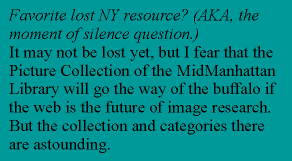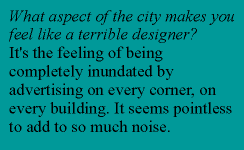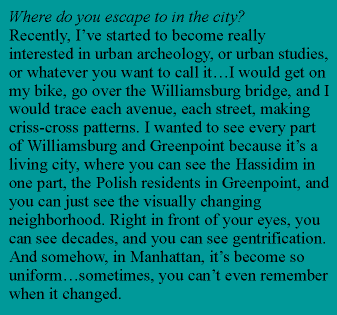 The Online Magazine about New York Designers |

|
Starting out as a designer of science fiction
book covers, Shelley Eshkar is now creating digital interpretations
of the human form – stuff that itself could have been the subject of
a sci fi novel. His recent works, with collaborator Paul Kaiser, interpreted
the dance forms of Merce Cunningham and Bill T. Jones. Now he wants
to digitize the movements of regular New Yorkers. DB: In your pieces "Ghostcatching" and "Bi-Ped," you were almost inventing a new genre. It was dance, but it was a new type: a cyberdance. Without a grounding in dance, do you think you had a fresher eye? Or, did you need to learn dance to create your interpretations? SE: I asked myself those questions as I began the project. Do I have to know how to dance? Do I have to interview the dancers? I remember I did start to take some dance related classes at my gym [and] I flirted with the idea of taking a little bit of Cunningham technique. I did take a lot of yoga. And as a digital designer -- spending all of your time hunched over the computer keyboard, like a human question mark -- you're moving fewer and fewer parts of your body. You've thrown away drawing the figure, and you're not even doing physical work anymore at some point. And suddenly, it's all about moving bodies again. It's all about observing people on the street. I had some of the Cunningham dancers come over to my home, where they explained their rotation, and moved around, and so some of that started to trickle in. |
|
|
SE: Merce uses chance operations when he creates his
works. It's a method that he and John Cage came up with where they unhinged
the music from the dance and made them independent entities; duration
is the only thing that brings them together. So Merce d LG: You studied fine arts, but then got into designing science fiction book covers soon after... SE: I was a science fiction fan, yet I had a healthy disrespect for it because it has a horrible visual culture. There are parts of science fiction [imagery] which are so beautifully goofy or kitschy, that I love just for that, but I wanted to bring a contemporary sensibility to it. And to this day, I still have not found a graphic design problem that's as interesting, where you can take such a personal point of view, and in which no one can really predict what you are going to end up with. DB: You went from there, to working on multi-media projects, starting with a CD for the Keith Haring Foundation. Was it a natural transition from that to what you are doing now? SE: I think that our goal at the time was to make projects that would be seen in museum gift shops. But they were essentially art catalogs; they were not yet artworks. It seemed that it was the time to make artworks on our own. So we basically dropped all of our clients and went into a freefall, trying to actually self-produce projects, conceiving new work for digital media, [rather than] recycling old work. LG: So you then came back to focusing on the body, creating virtual bodies which were projected -- sometimes on to the dancers' bodies -- during performances? SE: In my first years of art school [at Cooper Union],
I had dropped drawing the figure; I had really felt that it was way
too romantic. I was not interested in representation. I became interested
in abstraction, and constructing, and conceptual art and ideas, and
I felt that drawing the body was something that you do to build your
draftsmanship skills. Now suddenly, I found myself in the position of
having to draw, or render the body, once again, probably in the most
r LG: When you think about dance, it's all about the dancer's presence: the presence of the person moving and, in a sense, their personality. |
||
  |
DB: He generated that name? SE: Yes. And he was also rather defiant. He started by saying, "I wager that anything that I can do with my body is far more interesting than anything you can do with that computer." And indeed, as he danced, he has this liquid esthetic, and he has this real presence, and y'know, sensors were popping off of him, and our data looked terrible when we first began. LG: You're now an artist in residence with the Lower Manhattan Cultural Center in an unusual work space up in the World Trade Center. Is this influencing your current work? SE: Our next piece is going to be specific to New York. It's about New York pedestrian life, and part of the homework for that is walking away from my computer, moving through the city, and observing how people really move. We intend to get beyond the virtuosic movements of dance, and into the dance of everyday life. DB: Is this a collaboration also? SE: This is a collaboration with Paul [but] it's going to be our first collaboration without a famous choreographer. The idea here is to make a piece of public art. You imagine a digital crowd of New Yorkers, little tiny people, and you see them from above, as though from the top of a tall building, and you start to get a sense of this crowd, almost the way you think about ants or a beehive. The colony has its collective fluids; it's a single organism. DB: There's a film you should see. It was made by a sociologist
looking at the way pl LG: It was by Holly Whyte [William H. Whyte] and we saw it recently through the Municipal Art Society. It was all about things like, where do people sit at these plazas; why do they sit at some plazas, and not at others? What times of the day? Which ways do they face? It was very interesting, and very much about clusters and people moving as a whole unit… SE: They've also done studies at Grand Central Terminal, and they've found that there are virtually no collisions. Recently, I read in Discover magazine about architects designing around catastrophes. In the tunnel to Mecca, thousands of people have gotten killed over the years from the stampedes. And in soccer games. And they're working to study the locomotion and the psychology of these crowds in order to figure out where to make the release, where to break those stresses, so that people can ‘leak out.' DB: Your project sounds like a fantastic study. SE: Except ours is total fiction… DB: Is it? SE: It goes back to fiction. Our work does seem to parallel some science fiction. LG: How so? SE: In that article, they found that the reasons for these catastrophes had almost nothing to do with human psychology, it was just physics; it was about flow. Modeling human psychology is so tricky, it's more likely you're going to come up with a physical explanation. If you are watching the animation, you'll see a bunch of little figures and their shadows moving around. And of course, we'll have women who've just come from Fifth Avenue, shopping, we'll have businessmen, we'll have punks, we'll have bike messengers; each of the little characters is a body I'm building, and I intend to model both of you… LG: Yay! I want to be in this! What should I wear? (laughter) SE: The image is going to be projected;
[perhaps] from a street lamp, onto the ground. And with a rather high
powered projection, it will make a large rectangle of light the In some ways now, we're beyond the issues of control or choice vs. chance because, at some point, it's so complex. How are you, as a single person, even as a choreographer, going to design the movements, the collisions, the conflicts, of hundreds and hundreds of characters? And this is where we've had to study a bit of science – computer science areas like flocking, as in flocking of birds, where they do biological simulations [of individual and group behaviors]. So we start to build up all of the rules and all of the behaviors into this system and, instead of a single person designing this system, you just let it go. The end result is you've designed something which you could not have micro-managed; something emerges which has a mind of its own. Let's say you imagine, "what is a crowd formation, in NYC, during the Halloween parade?" [and] "what is the crowd formation in a Busby Berkley film, when everyone's dancing?" Can you, in a computer, take a Busby Berkley film, and put it next to the people in the Halloween parade? How do the two start to pollute each other? How does one turn into the other? What happens if someone screams ‘fire?' Does that ripple through all the entities? Suddenly, you start to invest human psychology into all of this activity, and it gets to be very, very strange. And, that's where I feel like, though we may start with the study of real crowds, it's going to be a work of pure fiction. DB: With some chaos theory thrown into it. (laughter) |
|
Click to read
part 2. (You're more than half way through....)



 oes
not hear the music that John is creating. He only knows that it's 45
minutes long, and the same thing goes with Merce. They're free to be
themselves, and they come together in the end. And the same was true
for us working on "BiPed." We saw pieces of the choreography, and of
course, during capture, we had a few samples in our head [and] in our
computers. [But] we had no way of knowing the structure of the piece
at all. It was only in the premiere in Berkeley, where we got to see
the whole piece come together.
oes
not hear the music that John is creating. He only knows that it's 45
minutes long, and the same thing goes with Merce. They're free to be
themselves, and they come together in the end. And the same was true
for us working on "BiPed." We saw pieces of the choreography, and of
course, during capture, we had a few samples in our head [and] in our
computers. [But] we had no way of knowing the structure of the piece
at all. It was only in the premiere in Berkeley, where we got to see
the whole piece come together.  omantic
way, [but now] through technology. The challenge was to re-learn gesture
drawings. In art school, when you are drawing a gesture drawing, what
you really have is usually a nude person standing there, pretending
to move, but they're really still. And you are inferring some movement,
you are having these moments of empathy, where you make all these arabesque
shapes and scribbles and your little nuances. But those really turn
out to be mannerisms once you're actually working with true motion,
and, so the process of making these bodies requires you to put away
some of those mannerisms and prejudices. You're working more like, I
think, a costume maker or a puppet maker, or someone building a wire
sculpture, in three dimensions, almost context-neutral, and it's sending
them into motion that really tells you if they're true or not.
omantic
way, [but now] through technology. The challenge was to re-learn gesture
drawings. In art school, when you are drawing a gesture drawing, what
you really have is usually a nude person standing there, pretending
to move, but they're really still. And you are inferring some movement,
you are having these moments of empathy, where you make all these arabesque
shapes and scribbles and your little nuances. But those really turn
out to be mannerisms once you're actually working with true motion,
and, so the process of making these bodies requires you to put away
some of those mannerisms and prejudices. You're working more like, I
think, a costume maker or a puppet maker, or someone building a wire
sculpture, in three dimensions, almost context-neutral, and it's sending
them into motion that really tells you if they're true or not.  azas
in the city are used. There were shots from above, as you were talking
about, and some timed sequences over the course of the day, looking
at the types of interactivity.
azas
in the city are used. There were shots from above, as you were talking
about, and some timed sequences over the course of the day, looking
at the types of interactivity.  re.
I suppose each figure would be about the size of a salt shaker. And,
being a public work, outdoors, it's something you would chance upon
while coming back from work and you'd see this strange apparition on
the street. Our idea is to have this outside a gallery or a museum setting
and to hit four different locations in New York representing four really
different neighborhoods.
re.
I suppose each figure would be about the size of a salt shaker. And,
being a public work, outdoors, it's something you would chance upon
while coming back from work and you'd see this strange apparition on
the street. Our idea is to have this outside a gallery or a museum setting
and to hit four different locations in New York representing four really
different neighborhoods.